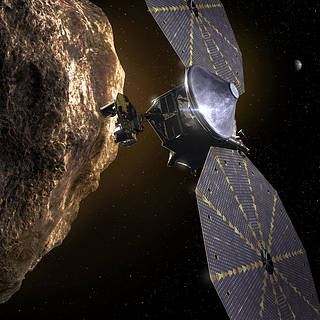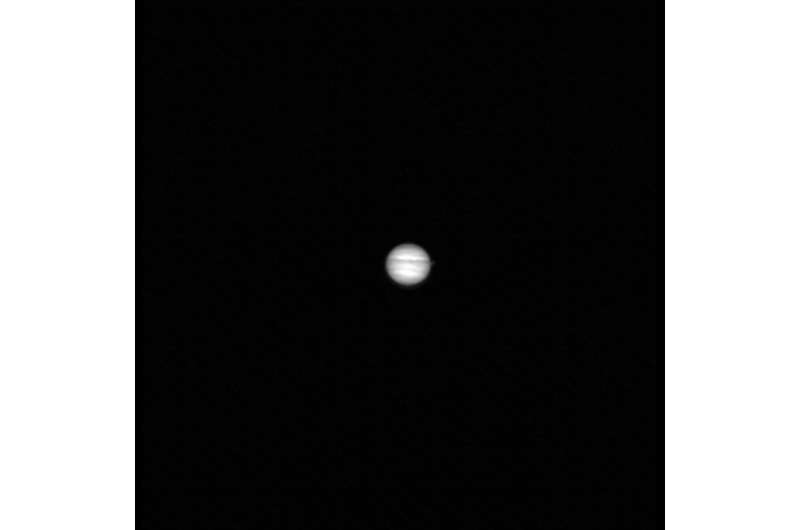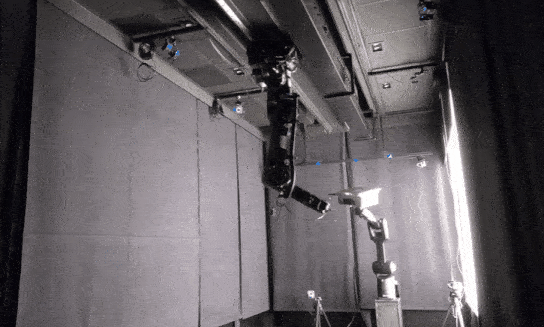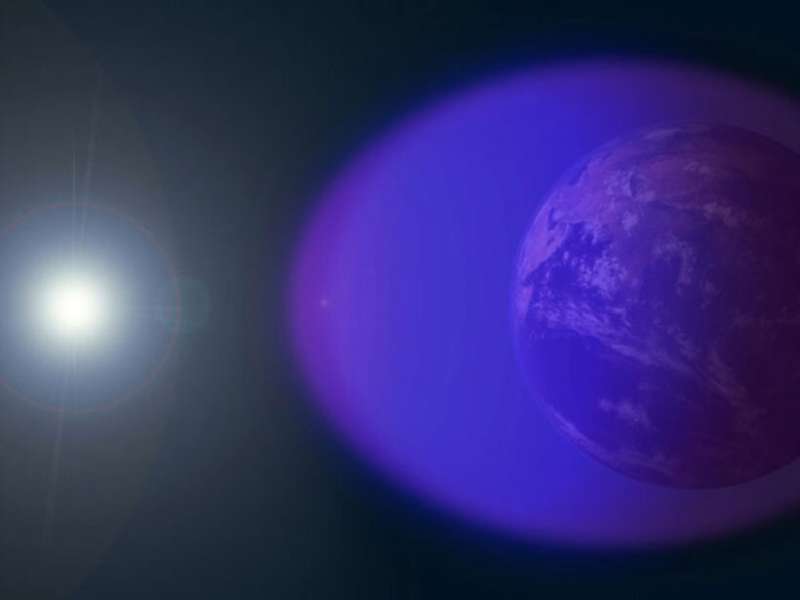
Copernical Team
NASA Sets Coverage, Invites Public to Virtually Join Lucy Launch
 NASA will provide coverage of upcoming prelaunch and launch activities for Lucy, the agency’s first mission to explore the Jupiter Trojan asteroids.
NASA will provide coverage of upcoming prelaunch and launch activities for Lucy, the agency’s first mission to explore the Jupiter Trojan asteroids. NASA spacecraft takes a picture of Jupiter … from the Moon

You may know the feeling of seeing Jupiter through your own telescope. If it gives you the chills—like it does for me—then you'll know how the team for the Lunar Reconnaissance Orbiter felt when they turned their spacecraft around—yes, the orbiter that's been faithfully circling and looking down at the Moon since 2008—and saw the giant planet Jupiter with their camera. If you zoom in on the picture, you can even see Jupiter's Galilean moons.
Usually, LRO takes stunning, high-resolution images of the lunar surface, including details of the Apollo landing sites. But recently, the LRO team used some high-powered calculations and precise timing to use its Lunar Reconnaissance Orbiter Camera (LROC) to scan the area of the sky where Jupiter was going to be, about 600 million km away.
They hit the jackpot.
While it's not Hubble Space Telescope quality, the fact this image was taken from a spacecraft orbiting 100 km above the lunar surface is a true feat of engineering.
"We took a pic of Jupiter from the Moon last month," said LRO team member Brett Denevi on Twitter.
Satellite models to strike a pose for competing AIs

Movie special effects fans like to debate CGI versus traditional model effects – an issue about which competing AIs will soon gain direct experience. Trained upon computer-generated images of satellites, AIs will go on to judge the position and orientation of realistic mockups snapped in space-like lighting conditions.
A step toward making GPS more resilient to space weather

Societies around the world now depend on satellite-based navigation systems, such as GPS, for a multitude of applications, including transportation, agriculture, military munitions, emergency services, and social networking, among others.
Spire Global and SpaceChain announce new partnership
 Spire Global has entered into a new partnership with SpaceChain, a global space-as-a-service solutions provider developing the world's first decentralized satellite infrastructure (DSI). Together, Spire and SpaceChain are launching a mission to demonstrate the feasibility of blockchain technology computation in space and resolve land-based centralized infrastructure issues.
Many in the blo
Spire Global has entered into a new partnership with SpaceChain, a global space-as-a-service solutions provider developing the world's first decentralized satellite infrastructure (DSI). Together, Spire and SpaceChain are launching a mission to demonstrate the feasibility of blockchain technology computation in space and resolve land-based centralized infrastructure issues.
Many in the blo SwRI scientists confirm decrease in Pluto's atmospheric density
 When Pluto passed in front of a star on the night of August 15, 2018, a Southwest Research Institute-led team of astronomers had deployed telescopes at numerous sites in the U.S. and Mexico to observe Pluto's atmosphere as it was briefly backlit by the well-placed star. Scientists used this occultation event to measure the overall abundance of Pluto's tenuous atmosphere and found compelling evid
When Pluto passed in front of a star on the night of August 15, 2018, a Southwest Research Institute-led team of astronomers had deployed telescopes at numerous sites in the U.S. and Mexico to observe Pluto's atmosphere as it was briefly backlit by the well-placed star. Scientists used this occultation event to measure the overall abundance of Pluto's tenuous atmosphere and found compelling evid Unique asteroid holds clues to early Solar System
 Set to launch next year, NASA's Psyche mission marks the first time the agency has set out to explore an asteroid richer in metal than rock or ice. More than 150 years have passed since novelist Jules Verne wrote "Journey to the Center of the Earth," but reality has yet to catch up with that science fiction adventure. While humans can't bore a path to our planet's metallic core, NASA has its sig
Set to launch next year, NASA's Psyche mission marks the first time the agency has set out to explore an asteroid richer in metal than rock or ice. More than 150 years have passed since novelist Jules Verne wrote "Journey to the Center of the Earth," but reality has yet to catch up with that science fiction adventure. While humans can't bore a path to our planet's metallic core, NASA has its sig HawkEye 360 reaches contractual milestone for delivering space-based radio frequency mapping
 HawkEye 360 reports it has secured new contracts totaling over $50 million in potential value since the start of the year as its next generation satellites have become operational.
"HawkEye 360 is experiencing an exceptional year, with record growth in customer engagements and bookings," said HawkEye 360 CEO John Serafini.
"We're building depth of customers across the United States,
HawkEye 360 reports it has secured new contracts totaling over $50 million in potential value since the start of the year as its next generation satellites have become operational.
"HawkEye 360 is experiencing an exceptional year, with record growth in customer engagements and bookings," said HawkEye 360 CEO John Serafini.
"We're building depth of customers across the United States, Cesiumastro deploys active phased array experimental satellites
 CesiumAstro, Inc. announces the successful launch and deployment of its first two satellites featuring their leading-edge communications payloads aboard a United Launch Alliance Atlas V-401 rocket. Dubbed Cesium Mission 1(CM1), the duo of satellites will provide an on-orbit testbed for next generation wireless communications and sensing technologies.
"We will see major advancements over th
CesiumAstro, Inc. announces the successful launch and deployment of its first two satellites featuring their leading-edge communications payloads aboard a United Launch Alliance Atlas V-401 rocket. Dubbed Cesium Mission 1(CM1), the duo of satellites will provide an on-orbit testbed for next generation wireless communications and sensing technologies.
"We will see major advancements over th SBIRS GEO-6 Space Vehicle completes production
 Space Systems Command's (SSC) Production Corps achieved a major milestone with the completion of the final Space Based Infrared System (SBIRS) satellite, SBIRS Geosynchronous Earth Orbit (GEO)-6 on Sept. 2 at Lockheed Martin's Sunnyvale, California production facility.
SBIRS GEO-6 will begin final preparations for a scheduled launch in the first half of 2022 on a United Launch Alliance Atl
Space Systems Command's (SSC) Production Corps achieved a major milestone with the completion of the final Space Based Infrared System (SBIRS) satellite, SBIRS Geosynchronous Earth Orbit (GEO)-6 on Sept. 2 at Lockheed Martin's Sunnyvale, California production facility.
SBIRS GEO-6 will begin final preparations for a scheduled launch in the first half of 2022 on a United Launch Alliance Atl 